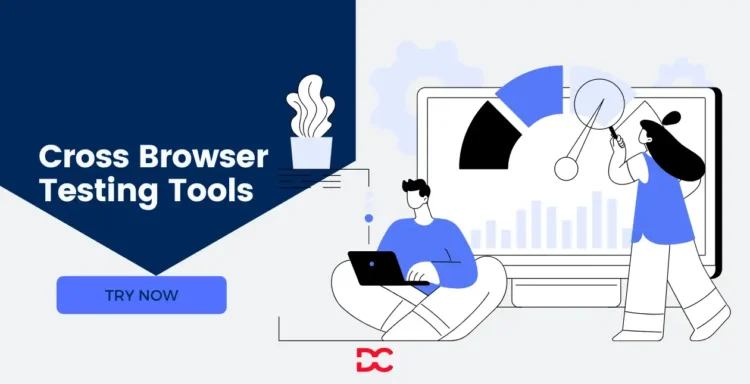To ensure that your website or web application works perfectly across all browsers, you need to perform cross-browser testing. This type of testing checks how your site or app looks and behaves on different browsers, operating systems, and devices. Today, there are several tools available that can help you with cross-browser testing.
The fierce competition among the various browsers has been a boon for the web development community. It has paved the way for the development of better cross-browser testing tools. In the past, developers had to contend with the fact that different browsers displayed web pages differently. This made it very difficult to develop web pages that were compatible with all browsers.
However, with the development of better cross-browser testing tools, developers can now quickly test their web pages on all major browsers. This ensures that the web pages are displayed correctly on all browsers and that the users have a consistent experience regardless of the browser they use.
Why is Cross Browser Testing Needed?
For web designers & developers, cross-browser testing is essential. Especially for front-end developers who work on design aspects of the website, cross-browser testing is often required to see how page layouts are looking on different browsers.
It ensures that the layout of your website doesn’t break or look weird in different browsers and avoids the chances of user experience issues.
However, cross-browser testing is a time-consuming and challenging task when done manually. That’s why we’ve put together this comprehensive list of the best cross-browser testing tools to save you time & effort.
- Cross-browser testing helps ensure your website works well on different browsers.
- Many tools are available to assist with this testing.
- Choose the right tool based on your needs.
- Use tools like BrowserShots for desktop browsers.
- Use simulators and emulators for testing on mobile devices.
- Test your website on various devices and platforms, both desktop and mobile.
- Have a clear plan for how to use the testing results to improve your site.
Best Cross Browser Testing Tools in 2025
Headspin

HeadSpin is a platform designed for mobile app and web performance testing. It helps developers and QA teams ensure that their applications work correctly across different devices, operating systems, and network conditions. Here are some key features of HeadSpin:
- Real Device Testing: Users can test their apps on real mobile devices located in different geographical regions, allowing for accurate performance insights.
- Network Simulation: HeadSpin can simulate various network conditions, such as 3G, 4G, and Wi-Fi, to see how apps perform under different circumstances.
- Performance Monitoring: The platform provides real-time monitoring of app performance, enabling users to identify issues and optimize their applications effectively.
- User Experience Testing: It allows teams to evaluate the user experience by assessing load times, responsiveness, and overall functionality.
- Automated Testing: Users can automate their testing processes, reducing manual effort and increasing efficiency.
Headspin is a powerful tool that can help you ensure that your website or application works correctly on all devices and browsers. However, it is also a premium tool, and its pricing can be prohibitive for some businesses.
LambdaTest

LambdaTest is a cloud-based cross-browser testing platform that offers a rich set of features to ensure your website or application functions flawlessly across various browsers and devices.
- Extensive Browser & Device Coverage: Test on over 3000 browser and device combinations, including popular desktop and mobile browsers, and access various operating systems like Windows, macOS, Android, and iOS.
- Automated & Live Interactive Testing: Automate testing using frameworks like Selenium and conduct live testing sessions to explore your website or app in real time.
- Visual Testing & Debugging: Perform visual regression testing to catch layout changes and use debugging tools to quickly find and fix issues.
- Geolocation Testing: Simulate different geographical locations to assess performance under varying network conditions.
- Network Throttling: Test how your site or app performs under slow or unstable connections for a smooth user experience.
- API Testing: Validate the functionality and performance of your APIs across different environments.
- Integrations: Seamlessly connect LambdaTest with your CI/CD pipeline for efficient testing within your development workflow.
TestingBot

TestingBot is a cloud-based cross-browser testing platform aimed at helping developers ensure their websites and apps function flawlessly across diverse browsers and devices.
- Extensive Browser & Device Coverage: Test on over 5100 browser and device combinations, including mainstream desktop and mobile browsers, real devices, and virtual environments, covering platforms like Windows, macOS, Android, and iOS.
- Automated & Live Testing: Integrate with popular frameworks like Selenium, Cypress, Appium, Puppeteer, and Playwright for efficient automated testing, and conduct live interactive sessions to explore your software and find issues in real-time.
- Visual Testing & Debugging: Catch visual regressions with automatic screenshot comparisons across browsers and devices, and use built-in debugging tools to quickly identify and fix issues.
- Real-Time Logs & Screenshots: Access detailed logs and visual representations of test steps for deeper insights into test execution.
- Parallel Testing: Run multiple tests simultaneously on different browsers and devices to speed up your testing process.
- Integrations: Seamlessly connect with your CI/CD pipeline for efficient and automated testing within your development workflow.
TestComplete

TestComplete stands out as a robust cross-browser testing tool designed primarily for software testing professionals. Here’s how it simplifies cross-browser compatibility testing:
- Automated Test Creation: Record user actions in one browser and easily apply them to others without manual changes.
- Scripted Testing: Use JavaScript or Python for detailed control and complex test scenarios.
- Keyword-Driven Testing: Create reusable keywords for common actions to simplify maintenance.
- Unified Object Model: Interact with web elements consistently across different browsers, avoiding repetitive code changes.
- Comprehensive Browser Support: Test on major desktop browsers like Chrome, Firefox, Edge, and Safari, and cover various mobile browsers on Android and iOS.
- Cloud-Based Integration: Connect with cloud-based testing services for wider browser support (additional setup required).
- Visual Verification: Compare screenshots across browsers to detect layout inconsistencies.
- Performance Testing: Identify and resolve performance bottlenecks before deployment.
- Parallel Testing: Run tests on multiple browsers at the same time for faster execution.
- CI/CD Integration: Seamlessly connect testing into your development workflow for efficiency.
TestGrid

TestGrid positions itself as a one-stop solution for cross-browser testing, catering to both technical and non-technical users. Here’s a breakdown of its key offerings:
Here are the features summarized in single points:
- Cross-Browser Compatibility on Real Devices: Test your website or app on over 1000 real devices and browsers hosted on a secure cloud, avoiding emulators and simulators.
- Real-World Performance Insights: Cover major desktop and mobile browsers across different operating systems to get accurate performance data.
- Automated Testing: Choose from frameworks like Selenium and Appium, or write custom scripts for complex testing scenarios.
- Codeless Testing: Use the record and playback feature or AI-powered tools to create tests easily, even if you’re not technical.
- Visual Testing: Automatically compare screenshots across browsers and devices to find layout issues.
- Built-In Developer Tools: Access native developer tools for each browser to make debugging and troubleshooting easier.
- Geolocation Testing: Simulate different locations to see how your site or app performs under different network conditions.
- API Testing: Check the functionality and performance of your APIs in various environments.
- CI/CD Integration: Seamlessly connect TestGrid with your continuous integration and delivery pipeline for automated testing in your workflow.
Katalon Studio

Katalon Studio takes a unique approach to cross-browser testing, merging ease of use with powerful features for both testers and developers. Here’s what makes it stand out:
- User-Friendly Interface: It has a simple and intuitive interface, making it easy for both beginners and experienced testers to use.
- Automated Testing: You can create automated tests for web applications, mobile apps, and APIs without needing extensive coding knowledge.
- Record and Playback: Katalon Studio allows you to record your actions in the browser and then play back those actions to create automated tests quickly.
- Cross-Browser Testing: It supports testing across different browsers like Chrome, Firefox, Safari, and Edge, ensuring your application works well everywhere.
- Integration with CI/CD: You can integrate Katalon Studio with continuous integration and delivery tools like Jenkins, Git, and Azure DevOps for smoother testing in your development workflow.
- Built-In Reporting: It provides detailed test reports and logs to help you understand test results and identify issues easily.
- Support for Multiple Testing Types: Katalon Studio supports functional testing, performance testing, and API testing, making it a versatile tool for various testing needs.
BrowserStack Live

BrowserStack Live stands out as a cloud-based, interactive cross-browser testing platform aimed at both developers and testers. Here’s how it helps you ensure flawless website and app functionality across diverse browsers and devices:
Here are the features of BrowserStack Live summarized in single points:
- Real-Time, Interactive Testing: Experience testing on over 3000 real desktop and mobile browsers and devices, allowing you to interact with your website or app like actual users and quickly spot issues.
- Parallel Testing: Conduct tests on two devices at the same time or use multiple browser tabs for faster and more efficient exploration.
- Access to Beta Releases: Stay updated with beta and development releases of popular browsers for early testing.
- Cross-Functional Collaboration: Share your testing sessions with team members in real time, even if they are in different locations, and work together to find and fix bugs.
- Annotation Tools: Use built-in tools to highlight specific areas during testing sessions for better communication with your team.
- Integrated Developer Tools: Access developer tools within each browser session for detailed debugging and troubleshooting.
- Network Throttling: Simulate different internet speeds to see how your website or app performs under various network conditions.
- Geolocation Testing: Test your site from different locations to understand its performance worldwide.
FAQs
How do I handle cross-browser testing?
I automate cross-browser testing by writing scripts that load my website in different browsers to mimic user visits and check transactions.
Can I automate cross-browser testing?
Yes, I can test my application on various browsers, screen sizes, and devices either manually or through automation.
What are cross-browser issues?
These issues arise from differences in how browsers display styles, causing problems like changes in font sizes, colors, and layout that can affect user experience.
Can I do cross-browser testing in Cucumber?
Yes, Cucumber integrates with CrossBrowserTesting, allowing me to test across many OS, device, and browser combinations from a single test.
Can I run parallel tests in different browsers?
Yes, I can perform Parallel Testing to run the same test on different browsers or various tests on the same or different browsers.
Can Selenium run in parallel?
Yes, I can use TestNG with Selenium for parallel test execution, speeding up my testing process and improving efficiency.
Conclusion
As browsers continue to evolve, testing your web application’s compatibility across different browsers becomes increasingly important. This blog has outlined the different cross-browser testing tools that are currently available and their various benefits.
By using these tools, you can test your web application on different devices, browsers, and operating systems without any real-world testing. Make sure to check out the blog for more information on cross-browser testing tools in the coming years!







